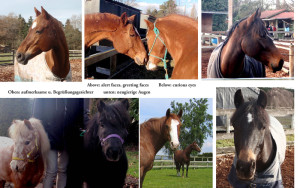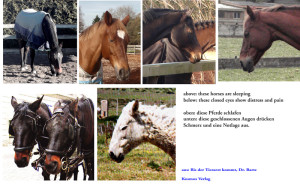Understand your Horse – Part 12
|
|
Ihr Pferd verstehen – Teil 12
|
Eyes 2
- In the last part we got an idea of how our horses perceive the world – quite differently from us! Now we want to look at the emotions reflected by his eyes.
1. Attentive eyes, bifocal, focussed and three dimensional vision:
- We already saw that the ears give us a clue of what the eyes are looking at! When the horse is watching something in the focussed range in front of his face (those 15 to 20 degrees, where he gets a three dimensional picture) his ears are both pointed to the front as well. This expression we know from the “greeting faces” (top row centre) and attentive alert faces (right and left).
|
|
Augen 2
- Im letzten Blog haben wir eine bessere Vorstellung davon bekommen, wie unser Pferd die Welt sieht – ziemlich anders als wir! Jetzt wollen wir sehen, wie es seine Gefühle mit den Augen ausdrückt.
1. Aufmerksame Augen, bifokal, scharfes und drei dimensionales Sehen:
- Wir haben ja schon bemerkt, daß die Ohren des Pferdes uns eine Andeutung davon geben, was die Augen betrachten! Wenn das Pferd in dem Winkel des scharfen Sehens vor seinem Gesicht (in eben diesen 15 bis 20 Grad, wo es ein dreidimensionales Bild bekommt) etwas anschaut, dann sind seine Ohren auch beide dahin gespitzt. Diesen Ausdruck kennen wir ja schon von den „Begrüßungsgesichtern“ (oben Mitte) und den aufmerksamen Ohren (rechts und links).
|
|
|
2. Curious eyes¸ interested eyes:
- In the lower row you see curious eyes: fairly wide open but relaxed, accompanied by ears turned into the direction of the interesting object to be seen. This is no more than a “hey, what’s up?” mood, totally without apprehension. Czar (centre) is so relaxed that his lower lip is hanging down. The black mini (left) is just curious, whereas the lighter one has his eye on his buddy AND the surroundings – he doesn’t quite trust the situation!
3. Half closed: a) peaceful relaxation, or dozing
- Half closed eyes can have different meanings. Most often they express peaceful relaxation or dozing, as you see in the top row of the following picture. The ears can be pointed, as the horse is still taking in the surroundings to a certain degree, but the mouth is relaxed. The horse on the right is actually undergoing a very relaxing tail stretch, and is completely relaxed while his ears are on his human.
|
|
2. Neugierige, interessierte Augen:
- In der unteren Reihe sieht man neugierige Augen: ziemlich weit offen, aber entspannt, begleitet von Ohren, die in die Richtung gedreht sind, wo etwas interessantes zu sehen ist. Dieser Ausdruck sagt bloß „hey, was ist los?“, ganz ohne Besorgnis. Czar (mittleres Bild) ist so entspannt dabei, daß seine Unterlippe runterhängt. Das schwarze Mini (links) ist nur neigierig, während das helle ein Auge auf seinen Kumpel UND die Umgegend hat – der traut der Situation noch nicht ganz!
3. Halb geschlossen: a) friedlich entspannt oder dösend
- Halb geschlossene Augen können verschiedene Bedeutung haben. Meistens drücken sie friedliche Entspannung oder Dösestimmung aus, wie man in der obneneren Reihe der Bilder sieht. Die Ohren können gespitzt sein, da das Pferd die Umwelt durchaus noch bis zu einem gewissen Grad wahr nimmt, aber das Maul ist entspannt. Das Pferd rechts genießt gerade ein sehr entspannendes Schweifstretching, und hat seine Ohren auf seinen Menschen gerichtet.
|
|
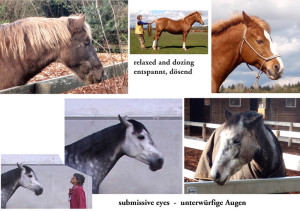
|
4. Half closed: b) submission, appeasement
- In the bottom row you see half closed eyes as a sign of submission: here they are the opposite of a frontal stare – therefore saying: “I am in no way challenging you or trying to start any kind of an argument!” Again we see that the expression is simultaneously reflected by the language of the ears, which we discussed earlier. Galathee (on the left) is yielding backwards on command (by her trainer staring into her eyes). The horse on the right further emphasizes her submission by turning her entire head away “I am truly NOT looking for a confrontation!”
5. closed eyes: a) sleeping
When the horse is truly sleeping, the eyes are completely closed. The deeper the sleep (and the greater the trust in peaceful and safe surroundings) the lower the ears and the head may droop at the same time. On the left you see Deena, who sleeps so deeply that she nearly topples over. The lower lip is always relaxed and often hanging down in quite a pronounced manner. |
|
4. Halb geschlossen: Unterwürfig, beschwichtigend
- In der unteren Reihe drücken die halb geschlossenen Augen Unterwürfigkeit aus: hier sagen sie das Gegenteil von einem frontalen Anstarren – nämlich „ich versuche ganz und gar nicht dich herauszufordern, ich will keinerlei Streit!“ Wieder sehen wir, daß das selbe gleichzeitig mit den Ohren ausgedrückt wird, was wir ja schon früher gezeigt hatten. Galathee (links) weicht gerade rückwärts auf ein Kommando ihres Trainers durch Anstarren. Das Pferd weiter rechts betont seine Unterwürfigkeit noch dadurch, daß es seinen ganzen Kopf weg dreht „ich will wirklich keinerlei Konfrontation!“
5. Geschlossene Augen: a) Schlaf
- Wenn das Pferd wirklich schläft, sind die Augen zu. Je tiefer der Schlaf (und je größer das Vertrauen in eine friedliche und sichere Umwelt) desto tiefer können die Ohren und der Kopf gleichzeitig absinken. Links sieht man Deena, die in so einem Tiefschlaf fällt, daß sie fast dabei umkippt. Die Unterlippe ist immer entspannt und hängt oft ganz betont herunter.
|
|
|
6. Closed eyes: b) exhaustion or pain
- Danger!! When we looked at the horses’ ears we already learned that this expression can be a deceiving one and must NOT be confused with drooped ears and eyes as an expression of exhaustion or pain! The poor Vienna Fiaker horses (bottom left) are completely exhausted and the white horse on the right is ill. In case of doubt, therefore, when you see an expression like this, and the situation tells you that it may not be a normal snooze for your horse – check out his physical and mental state to make sure! Just because horses suffer in such a dignified way and without moaning and complaining does not mean that they do not need help!
-
7. „Reduced“ eyes: depressed, resigned
- This expression is hard to see – and even harder in a photograph! It looks as if the horse turns his vision (his action of seeing) inward, like we humans do when we un-focus our eyes in a dreamlike state. This is very typical for a horse during a painful colic – their entire being is “listening” into the pain in their bellies, and other stimulants from the outside are not taken in at all. (picture right)
|
|
6. Geschlossenen Augen: b) Schmerz oder Erschöpfung
- Gefahr!! Als wir die Sprache der Pferdeohren betrachtet haben, lernten wir schon, daß der schläfrige Ausdruck mißverstanden werden kann, und NICHT mit dem Ausdruck von Schmerz oder Erschöpfung verwechselt werden darf! Die armen Wiener Fiakerpferde (unten links) sind total erschöpft und das Pony rechts ist krank. Wenn man so einen Ausdruck sieht, muß man also im Zweifelsfalle – wenn die Situation einem sagt, daß ein normales Nickerchen zu dieser Zeit unwahrscheinlich ist – immer den Gesundheitszustand und die seelische Verfassung prüfen! Nur weil Pferde so würdevoll und ohne Wimmern und Klagen leiden, heißt nicht, daß sie keine Hilfe brauchen!
7. „Zurückgenommener Blick“: deprimiert, resigniert
- Dieser Ausdruck ist schwer zu erkennen – mehr noch auf einem Bild! Es sieht aus, als ob das Pferd seinen Blick nach innen dreht, wie wir Menschen es tun, wenn wir unsere Augen träumerisch „unscharf“ stellen. Das ist sehr typisch für Pferde während einer Kolik – ihr ganzes Wesen „horcht“ in das Bauchweh hinein, und alle anderen Reize von außen werden nicht wahrgenommen (Bild rechts).
|
|
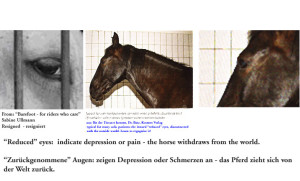
|
- The horse on the left, though his eyes are open, looks at nothing at all. He shuts out all incoming information – he doesn’t care about anything anymore. Horses that are resigned to be left alone in the cage of their stall for long times look like that. This is a sign of depression! Such a horse needs help too !!
8. Showing some white: worried eyes
- The eyes of horses differ – and you know what your horse’s eyes look like, when he is relaxed. Some horses show the white of their eyes more easily than others. Beau (on the right, top row of the next picture) often shows some white, even when he is not particularly worried, but just looking to one side. A horse like Peter (next picture frontal view) however only showed the white of his eyes, when he ripped them open when worried. With him it was always a sign that he needed reassurance about the situation. The important thing is that you should learn to pay attention to it AND REACT! When your horse is worried, YOU, as a good leader and friend, should DO something about it! Review the situation, solve the problem, reassure your friend – don’t just look at him.
|
|
- Obwohl das Pferd links die Augen offen hat, sieht es gar nichts an. Auch es hat den verinnerlichten Blick, der die Außenwelt ausschließt – es hat aufgegeben. Pferde, die gewohnt sind lange Zeiten alleine in dem Gefängnis ihrer Box stehen zu müssen, sehen so aus. Das ist ein Zeichen von Depression! Solche Pferd brauchen Hilfe!!
8. Ein bißchen weiß: besorgte Augen
- Pferdeaugen sehen unterschiedlich aus – und die Ihres Pferdes kennen Sie ja. Manche Pferde zeigen ein bißchen weiß des Augapfels, auch wenn sie entspannt sind. Bei Beau (rechts oben im nächsten Bild) sieht man oft das Weiße ein wenig, auch wenn er nicht besorgt ist, sondern nur zur Seite schaut. Ein Pferd wie Peter (Frontalansicht) dagegen zeigt das Weiße nur, wenn es sie besorgt aufreißt. Bei ihm war es immer ein sicheres Zeichen, daß er Rückversicherung über die Situation brauchte. Das Wichtige ist ja nur, daß Sie lernen darauf zu achten UND dann zu REAGIEREN! Wenn Ihr Pferd beunruhigt ist, müssen SIE als guter Anführer und Freund etwas dagegen TUN! Prüfen Sie die Situation, lösen Sie das Problem, beruhigen Sie Ihren Freund – schauen Sie nicht bloß hin!
|
|
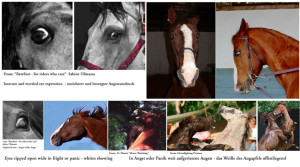
|
9. Wide eyes: fear, panic, flight or real anger
- The bottom row of the picture series shows horses in dire situations – here you see the expression of real fright or panic, also real anger in fight. The eyes are ripped wide open and the white is showing, but often they are rolled back as well. Obviously I do not have pictures like this from my own horses – therefore the quality of the photographs is not good – but who wants to see such fear and panic in great detail? Not I. Let’s hope you never have to either!
In the next Blog we will finish with the expression of the eyes
Read on !!
|
|
9. Weit aufgerissen: Angst, Panik, Flucht oder echte Wut
- Die untere Reihe der Bilder zeigt Pferde in schrecklichen Umständen – hier sieht man den Ausdruck von richtiger Angst oder Panik – auch Wut im Kampf. Die Augen sind weit aufgerissen und verdreht und das Weiße klar sichtbar. Solche Bilder habe ich von meinen eignen Pferden natürlich nicht – daher ist die Qualität der Bilder nicht gut – aber wer will schon solche Angst und Panik in großem Detail sehen? Ich nicht. Hoffentlich müssen Sie es auch nie!
Im nächsten Blog schließen wir mit den Augen ab.
Lesen Sie weiter!!
|

